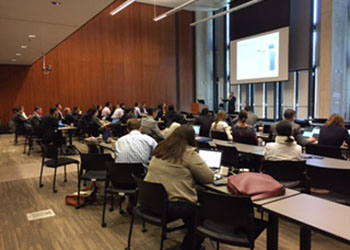UC San Diego Hosts Robotics Collaborative Annual Meeting
May 27, 2017
On May 19, 2017, UC San Diego’s Department of Surgery hosted the 2017 UC Collaborative Symposium on Robotic Surgery Education (pdf). The UC Robotics Collaborative is a UC-wide diverse group of academic surgeon-educators whose goal is to improve the quality and consistency of resident education in robotic surgery, a burgeoning field. Launched by UC Davis in 2016, this year’s annual meeting was organized by Dr. Lisa Parry , Assistant Professor of Surgery in the Colorectal Division of the Department of Surgery and Dr. Bryan Sandler , Associate Professor, and was attended by representatives from UC Davis, Irvine, Los Angeles, Riverside, San Diego, and San Francisco.
Says Parry: “Robotic surgery is a major innovation, particularly in colorectal surgery, where something like 80-90% of our colon and rectal surgeries are being performed using the robot. Robots improve visualization, help surgeons get into small spaces where hands are too big, and allow more precision.”
Robotics is used extensively in urology and gynecology; and occasionally in thoracic and cardiac surgery. Other specialties such as ENT are just beginning to explore the application of robotics in their surgical specialties.
UCSD’s Department of Surgery had representatives at the meeting from all surgical specialties, and gave several presentations, including a presentation by third-year surgery resident Dr. Sarah Stringfield (pdf) entitled “10-year review retrospective review of a robotics program at a major academic institution.” Dr. Stringfield also presented at the Royal College of Surgeons in Adelaide, Australia in May.
Training the next generation of surgeons on robotics is a priority of the Department of Surgery. When Parry first joined UCSD in 2015, having come from Kaiser in Atlanta, the Department of Surgery did not yet have a training curriculum program for robotic surgery. Parry, together with Dr. Sandler, helped to develop the Department’s first robotics training curriculum, based largely on curriculum from the University of Alabama, which has extensive experience in training residents in robotic surgery. Although industry leaders have preferred short, 2-day training courses, UCSD’s approach stresses cross-disciplinary education, and includes simulation, web-based education, bedside assistant cases, and console cases.
Educating residents in the use of robots has not been completely straightforward. Prior to the curriculum being in place, residents were not able to participate on the console, and were often disinterested and disconnected from the surgery. It was difficult to attract residents to attend and participate in the cases because, according to Parry, “they felt they weren’t able to do anything—to contribute.”
But since the new curriculum has been in place there has been a change in residents’ excitement and participation in robotic cases. At this year’s meeting, residents expressed interest in better understanding which steps in a robotic procedure are possible and appropriate for them to do safely, to enable more hands-on learning. “We as faculty want to know what the steps are and which ones are appropriate for residents, so our goal is for each specialty to get to work on this over the next six months,” says Parry.
 In the fall, the Collaborative plans to do a WebX to check up on the progress of each institution with the curriculum and to discuss any roadblocks the UCs have encountered. Planning is also underway for next year’s annual meeting.
In the fall, the Collaborative plans to do a WebX to check up on the progress of each institution with the curriculum and to discuss any roadblocks the UCs have encountered. Planning is also underway for next year’s annual meeting.
“Drs. Parry and Sandler are to be congratulated for taking on this challenging task,” says Dr. Sonia Ramamoorthy, Professor of Surgery and Chief of the Division of Colorectal Surgery. “Our national societies are still trying to sort out how to effectively train the next generation in robotics, and these two are way ahead of the pack. As a result of their efforts, our UCSD surgery residents and the UC system’s surgery residents will have an opportunity to develop a skillset few other programs can offer.”
